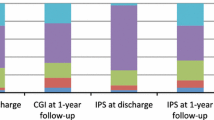Abstract
Objective
Even if the majority of patients with Guillain–Barré syndrome (GBS) have a favourable functional outcome some residual motor and sensory signs and symptoms may remain. The aim of this study was to evaluate the long–term effect of GBS on daily life,working activities, hobbies and social status and the presence of residual symptoms.
Patients and methods
Seventy patients with GBS enrolled in a case–control study were examined. Information on signs or symptoms during the acute phase of the disease was retrieved from medical records and an ad–hoc questionnaire administered during hospitalization. Patients were interviewed by phone 3 to 5 years after disease onset about residual symptoms and changes in daily living. Disability and handicap were assessed using the Hughes, Rankin and Rotterdam 9–items scale.
Results
At follow–up 45 patients (64 %) made a complete functional recovery; 19 patients (27%) had some minor limitations in daily life although they were able to perform all their activities independently while 6 (9 %) needed aid for some hours or continuously during the day. Nineteen patients (27 %) had, however, to make substantial changes in their job, hobbies or social activities. There was no significant correlation between clinical and laboratory features during the acute phase of GBS and outcome.
Conclusions
Althoough over 90% of our GBS patients had a more or less complete functional recovery, almost 30% of them had to make substantial changes in daily life. These findings indicate that GBS still has a significant impact on patients' life which may go beyond their residual disability or impairment. Treatment of GBS should not be only aimed at improving patients' disability but also at limiting the impact of the disease on their social life.
Similar content being viewed by others
References
Asbury AK, Cornblath DR (1990) Assessment of current diagnostic criteria for Guillain–Barré syndrome. Ann Neurol 27(Suppl):S21–S24
Bahou YG, Biary N, Al Deeb S (1996) Guillain–Barré syndrome: a series observed at Riyadh Armed Forced Hospital January 1984–January 1994. J Neurol 243:147–152
Bernsen RAJAM, de Jager AEJ, Schmitz PIM, van der Mechè FGA (2002) Long term impact on work and private life after Guillain–Barrè syndrome. J Neurol Sci 201:13–17
Carpo M, Allaria S, Scarlato G, Nobile– Orazio (1999) Marginally improved detection of GM1 antibodies by Covalink ELISA in multifocal motor neuropathy. Neurology 53:2206–2207
Cheng Q, Jiang GX, Press R, Andersson M, Ekstedt B, Vrethem M, Liedholm LJ, Lidtsen H, Brattstrom L, Fredrikson S, Lonk H, de Pedro–Cuesta J (2000) Clinical Epidemiology of Guillain– Barré syndrome in adults in Sweden 1996–1997: a prospective study. Eur J Neurol 7:685–692
De Jager AE, Minderhoud JM (1991) Residual signs in severe Guillain–Barré syndrome: analysis of 57 patients. J Neurol Sci 104:151–156
Dornonville de la Cour C, Jacobsen J (2005) Residual neuropathy in longterm population–based follow–up of Guillain–Barré syndrome. Neurology 64:246–253
Fletcher DD, Lawn ND, Wolter TD, Wijdicks FM (2000) Long–term outcome in patients with Guillain–Barré syndrome requiring mechanical ventilation. Neurology 54:2311–2315
Guillain–Barré Syndrome Study group (2000) The Guillain–Barré syndrome: an Italian multicenter case–control study. Neurological Sciences 21:229–234
Hartung HP, van der Mechè FGA, Pollard JD (1998) Guillain–Barré syndrome, CIDP and other chronic immune–mediated neuropathies. Curr Opin Neurol 11:497–513
Holman R, Lindeboom R, Vermeulen M, de Haan RJ (2004) The AMC Linear Disability Score project in a population requiring residential care: psychometric properties. Health Qual Life Outcomes 2:42
Hughes RA C, Newson Davis JM, Perkin GD, Pierce JM (1978) Controlled trial of prednisolone in acute poly neuropathy. Lancet ii:750–753
Löffel NB, Rossi LN, Mumenthaler M, Lûtschg J, Ludin HP (1977) The Landry–Guillain–Barré syndrome. Journal of the neurological Sciences 33:71–79
Merkies ISJ, Schmitz PIM, van der Mechè FG, Saimjin JPA, van Doorn PA (2002) Psychometric evaluation of a new handicap scale in immune–mediated polyneuropathies. Muscle Nerve 25:370–377
Meythaler Jay M (1997) Rehabilitation of Guillain–Barré Syndrome. Arch Phys Med Rehabil 78:872–879
Molenaar DSM, de Haan R, Vermeulen M (1995) Impairment, disability, or handicap in peripheral neuropathy: analysis of the use of outcome measures in clinical trials in patients with peripheral neuropathies. J Neurol Neurosurg Psychiatry 59:165–169
Nyland H, Naess A, Skjaerven R (1984) Natural history and prognosis of Guillain–Barré syndrome. A follow up study of 160 cases in Western Norway. Acta Neurol Scand 69:266–267
Rankin J (1957) Cerebral vascular accidents in patients over the age of 60. II Prognosis. Scott Med J 2:200–215
Terenghi F, Allaria S, Scarlato G, Nobile–Orazio E (2002) Multifocal motor neuropathy and Campylobacter jejuni reactivity. Neurology 59(2): 282–284
Vedeler CA, Wik E, Nyland H (1997) The long term prognosis of Guillain– Barré syndrome. Evaluation of prognostic factors including plasma exchange. Acta Neurol Scand 95:298–302
Winer JB, Hughes RAC, Grennwood RJ, Perkin GD, Healy MJR (1985) Prognosis in Guillain–Barrè Syndrome. Lancet 25:1202–1203
Winer JB, Hughes RAC, Osmond C (1988) A prospective study of acute idiopathic neuropathy. I. Clinical features and their prognostic value. J Neurol Neurosurg Psychiatry 51:605–612
World Health Organisation (1980) International classification of impairments, disabilities and handicaps. Geneva:WHO
Author information
Authors and Affiliations
Corresponding author
Rights and permissions
About this article
Cite this article
Bersano, A., Carpo, M., Allaria, S. et al. Long term disability and social status change after Guillain–Barré syndrome. J Neurol 253, 214–218 (2006). https://doi.org/10.1007/s00415-005-0958-x
Received:
Revised:
Accepted:
Published:
Issue Date:
DOI: https://doi.org/10.1007/s00415-005-0958-x




